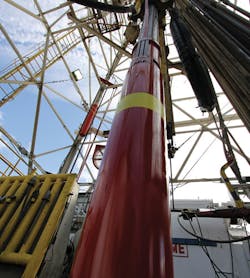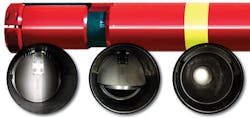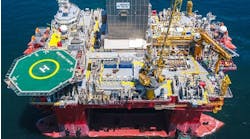Downhole deployment valve improves efficiency in underbalanced operations
Justin Cunningham
Weatherford
North Sea drilling conditions are notoriously challenging, especially with regards to safety, complexity, and cost factors. The offshore areas of interest are fraught with issues typically associated with remote, deepwater applications. Deepwater prospects and high-pressure/high-temperature wells, specifically, are prone to serious health, safety, and environmental risks, including potential damage to the formation itself. Adding more equipment and bringing on more personnel is one way to manage these challenges, but that just incurs more expense to an already costly endeavor. A new generation of sophisticated drilling methods, procedures, and specially designed equipment has been introduced to the region to help contain costs and mitigate risks inherent in precarious environments like the North Sea.
Weatherford recently took on an offshore jackup rig in the North Sea that required the deployment of a long completion string, comprised of 12 swellable packers in a multi-zone completion with 13 individual oil zones. The goal was to safely and efficiently deploy and trip the drillstring without killing the well or requiring installation of a snubbing unit while minimizing nonproductive time (NPT) and not adding equipment or personnel.
This was an ideal opportunity to use the Weatherford proprietary downhole deployment valve (DDV) system, developed to address such situations. The DDV system allows safe installation of drillstrings and completion assemblies during underbalanced operations and increases well productivity by avoiding formation damage. With the DDV system, the formation is actually protected from cyclical fatigue and damage caused by commonly used techniques, such as surging or swabbing the well. Furthermore, it enables faster tripping into the well.
A tandem DDV approach (comprised of both upper and lower DDV units) was decided upon for an extra measure of security. This solution enabled service team members to isolate the slightly underbalanced well in a conventional, completely controlled manner, and also to provide a safer, less expensive, and more efficient method of tripping drill pipe. Although used previously in numerous locations, this particular application represented the first deployment of a tandem DDV system in the North Sea. Moreover, the added use of downhole pressure gauges on this project helped mitigate pressure-related hazards.
DDV technology
The DDV design is essentially a deep-set flapper valve with a full-open internal diameter specification to match the casing. Its seal mechanism contains reservoir fluids in the casing, which prevents potentially hazardous pressure at the surface. Run as an integral part of the intermediate casing string, the DDV is typically set at a depth below the mudline, but placement is flexible and can be as deep as the well plan requires.
Again depending on job requirements, the DDV system can be configured either as permanent or retrievable. For permanent placement, the flapper valve is run in on the casing string and then cemented in place. If the retrievable option is preferred, the flapper valve is run in as part of the liner tieback string connected to the liner. This allows the valve and tieback string to be easily retrieved when drilling ends.
Hydraulic pressure applied from the surface controls the opening and closing of the valve flapper via two control lines within one encapsulation, which takes up less real estate and improves wellhead penetration. A separate lock-open tool can be used, if needed, to disable the DDV and provide full-open access should the control line become compromised.
Project details
The project team sought to accurately monitor downhole wellbore pressure by mounting pressure and temperature gauges both above and below the lower DDV. They ran in the lower completion string on drill pipe, using the DDV as a lubricator to accommodate a long, complex assembly. With the DDV in the open position, the assembly was tripped into the bottom of the well and then spaced out to secure it at the desired depth.
The following well completion steps were taken in preparation for any planned simulation operations that were part of the drilling program. A 4½-in. x 7-in. liner hanger and packer were set in the 7-in. liner, with the shoe at 17,619 ft (5,370 m) MD, and tested to 4,000 psi (276 bar). The 7-in. tieback casing and two DDVs were then retrieved from the well, and the 4½-in. upper completion was completed with a tieback seal. A 95⁄8-in. packer was run in the hole, spaced out, tied into the lower completion, landed, and set. Finally, the combined upper and lower completion string was tested to 6,000 psi (414 bar) as a safety measure to protect valuable rig assets and personnel during drilling and well operations.
Results summary
This was the first-ever deployment of a tandem DDV system in the North Sea with downhole pressure gauges in an underbalanced well. It provided several benefits to a complex completion installation, such as eliminating surface pressure during a significant portion of the tripping time, and reducing fluid losses or kicks when drilling in a reservoir with narrow pore pressure/fracture gradient windows. In the closed position, it also provided a lengthy lubricator to allow complex, intricate bottomhole assemblies.
The result was a trouble-free drilling and completion operation process with very little NPT. It was, therefore, considered an operational and economic success that provided safe, kill-free tripping, and important well information throughout the entire process. Furthermore, the DDV implementation established a secure barrier, which helped to isolate the well formation pressure below the flapper valve.
Overall, deployment of the DDV system saved the operator rig time, enhanced safety, and reduced drilling costs and risk exposure with faster tripping and elimination of the need for snubbing units or extra personnel.
Future applications
Laboratory testing can only go so far in analyzing well conditions. That makes the availability of historical data an important asset, especially as it pertains to using DDVs in future underbalanced and pressurized mud-cap drilling operations. History from prior applications will clearly demonstrate how to enable faster tripping, higher efficiencies, etc., which will, in turn, drive cost reductions.
To support the selection of best tools and practices, Weatherford has compiled an extensive database of DDV installation details from this and similar projects conducted around the world. A proprietary performance tracking system was used in this effort to gather valuable data that can be leveraged in the future by other E&P company drilling teams. A reliable source of historical information will enable high-quality decision making, because it documents proven DDV models to optimize any drilling scenario in theNorth Sea, or anywhere else, regardless of complexity. •





